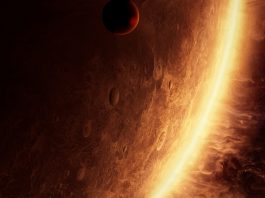The exoplanet WASP-76b, believed to be so hot that it rains iron, could be even more extreme than first thought.
Dr Ernst de Mooij, a researcher from Queen’s University Belfast, outlines the latest research findings that suggest that ionised calcium is also in its atmosphere. Since it was first discovered in 2016, the exoplanet WASP-76b has been under close observation as astronomers looked to find out more about the ultra-hot Jupiter. Recently, a team of researchers have found new evidence to suggest the fiery planet may be even more extreme than initially thought.
In research published in the Astrophysical Journal Letters, a team of scientists from Queen’s University Belfast, Cornell University, and the University of Toronto have revealed a new discovery of ionised calcium in the exoplanet WASP-76b’s atmosphere. To find out more about the latest findings and how the research was carried out, Innovation News Network spoke to Dr Ernst de Mooij, from the School of Mathematics and Physics at Queen’s University Belfast, who was involved in the analysis of the data.
Can you briefly explain the background surrounding the exoplanet WASP-76b and what we already knew about the planet?
WASP-76b is a planet that is much larger than Jupiter, and it orbits its star much closer than Jupiter does to our Sun. Jupiter is about five times the distance than the Earth is to our Sun. For this planet, it is just over 3% the distance of the Earth to our Sun. Because it is so close to the star, the planet’s dayside temperature reaches extremely high temperatures.
People who have observed it previously have found evidence suggesting that iron may be raining out on this planet, which has been dubbed as ‘iron rain’.
We used observations from the Gemini North Telescope near the summit of Mauna Kea on the island of Hawaii. There is an optical fibre that allows the light captured with this telescope to feed into ESPaDOnS, an instrument based at another telescope on the mountain. In this case, this enabled us to identify ionised calcium in the atmosphere of this planet.
What is your role at Queen’s University and how have you been involved in this research?
I am a lecturer at Queen’s University Belfast in the Astrophysics Research Centre, specifically in the exoplanet group. My base research focuses on studies of exoplanet atmospheres. In this project, I helped with the data analysis and with modelling the effect of the star.
There is an additional effect caused when a planet crosses a star. You need to imagine the star is rotating. For example, our Sun rotates roughly once every 25 days. This star is also rotating and is actually doing so a bit faster than our Sun. This means that one hemisphere is moving towards us, and another hemisphere is moving away from us. This cuts along the poles, separating the star into east and west rather than north and south.
The light from the hemisphere that is coming towards us is therefore blueshifted (a decrease in wavelength) and the other hemisphere is redshifted. As the planet moves across the stellar disk, it blocks different parts of the star, each moving at a slightly different velocity.
Effectively this means that, instead of having a nice smooth stellar line-profile, we get a bump at the velocity of the part of the star blocked by the planet at that time. This is referred to as the Rossiter-McLaughlin effect, which has been known for a long time. One of the things I did was model this effect to make sure that this did not impact our findings. We concluded that the effect is tiny and should not impact our findings, but we just wanted to make sure.
Can you detail the latest findings surrounding the exoplanet and explain how this was discovered?
We have a large programme called ExoGemS that is aimed at observing a whole sample of exoplanets, allowing us to study the properties across a range of different conditions. We are looking mainly at hot Jupiters, but at a range of different irradiations to slightly different stellar types, etc. The ultimate goal of the ExoGemS survey is to help us understand the family of planets and to gain a holistic view.
This was the first planet we observed as part of the survey, and the first that we analysed. What we found was that there is calcium in the atmosphere and, in particular, we looked for ionised calcium at wavelengths in the very near infrared. We cannot see these wavelengths with our own eyes, but it is still close to the optical. This ionised calcium shows a stronger absorption than we would have expected based on our models.
When a planet transits a star, it blocks some of its light. The atmosphere is essentially a shell around it. If you look at the wavelength where the atmosphere absorbs light, the planet appears to be slightly bigger, compared to wavelengths where light can just travel through freely. That is how we measure these signals.
What we found is that it looks like the atmosphere is much more extended, or that the calcium gas that we are seeing is a much larger distance from the planet than we originally expected. We think that there are two main reasons for this. There could be some winds in the planet that push the calcium to a very high altitude, very far away. It extends to a 10 to 20% larger radius, depending on the exact line we are looking at. That means we need to either transport it outwards, or make the atmosphere puffier, especially the upper envelope – the exosphere. This requires it to be hotter than we expect. I think it is probably a combination of these two factors that makes the signal so much stronger than we would have initially expected.
We measure these planets using high resolution spectroscopy, which means that we can see the individual lines. This is how, in this case, we can actually tell that the individual lines are significantly stronger than expected. If you look from Earth, we are looking through the Earth’s atmosphere. Luckily, the Earth’s atmosphere does not have a lot of calcium. However, the Earth has a lot of water vapour in it. It helps if we go up to Mauna Kea, which is one of the best astronomical sites as there is little water above it.
The water in the Earth’s atmosphere will absorb a small amount of light from the star and the planet, but the advantage is that the planet is orbiting its star at quite a high velocity, while the Earth’s atmosphere, as seen from the telescope, is stationary. This allows us to separate the water in the Earth’s atmosphere from that in the planet’s atmosphere, as they move at different velocities. The Earth orbits the Sun at 30km per second, while these hot-Jupiters can have orbital velocities of over 200km per second, so they are moving even faster.
Our next step for this particular planet is to conduct a comprehensive analysis to search for all kinds of atoms and molecules in the atmosphere – not just calcium.

What do these particular findings mean for our understanding of WASP-76b and for future exoplanet research?
Currently, our models are not good enough to fully understand these exoplanets. With this planet, it looks like the atmosphere needs to be puffier than we expect or that we need to get calcium further out. We do not fully understand the dynamics yet and we do not understand the temperature in the upper exospheres – the very outer layers – for these planets. In short, these findings have highlighted the fact that there is still a lot more work to be done. However, we now have an idea of where to go with our models and the people in our team are working on new models to try to incorporate this. Ideally, we would now be able to use this as a reference point to continue our research.
What are the next steps for your research?
In the ExoGems Survey, we are observing over 40 exoplanets in total. We hope to look at cooler planets as well to help build understanding and, at some point, we hope that we will no longer be able to see calcium anymore, because it will not be in enough abundance. We wish to start measuring these trends and gain further insight on what happens to planets.
There are still some open puzzles, such as a molecule called titanium oxide, which is predicted to be present in almost any planet that is very hot. So far, we have had very little success in finding it. We know it is present, for instance, in the Red Dwarfs called M dwarfs. We see the stars at temperatures that are similar to these exoplanets, so we would expect to see it here in hot planets, but we have had little luck in discovering it. One of the questions we are trying to answer, as an example, is why we do not see it. We need to determine, for instance, if we are not seeing it because we are looking at the wrong type of planets or if it is just not there.
Dr Ernst de Mooij Researcher School of Mathematics and Physics,
Queen’s University Belfast
www.qub.ac.uk
http://www.facebook.com/QUBelfast/
https://twitter.com/QUBelfast
Please note, this article will also appear in the eighth edition of our quarterly publication.









